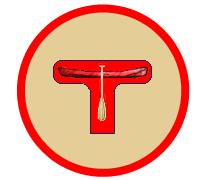Backcountry First-Aid Kit

When participating in a wilderness camping trip, whether for 1 day or weeks at a time, it is important to have a good first-aid kit with you. I personally maintain two first-aid kits: a "personal" first-aid kit and a "group" first-aid kit. I bring both on a canoe trip or hiking trip if I am the trip organizer but might only bring my personal kit if another member of the tripping party has been assigned the group first-aid kit.
A "group" sized first-aid kit is ideally waterproof, large enough to hold the contents and easily identifiable as a first-aid kit. A couple of options are:
- A large red bag designed to be a first-aid kit such as this one available at MEC. This style will need to be waterproofed inside a plastic bag or a waterproof pack. This bag also comes in a small size suitable for your personal first-aid kit that you can carry in your day pack.
- Waterproof Lexan gear box made by GSI Outdoors. Consider using red electrical tape to create a big red + on the box.
The following items make up my first-aid kits. The exact contents vary from time to time as items are used and then restored. The length of your trip and the number of participants will also be a factor when deciding what contents and quantities you bring. Special medical needs (allergies or asthma, for example) of you or others in your party should also be considered.
Important: These lists are to provide you with ideas only - I do not purport to be an expert. Do additional research and consult experts when building your own first-aid kit. In addition to having first-aid items you must know how to use them properly - a course on first-aid, especially a wilderness first-aid course for back-country trippers, is invaluable. Always follow the directions and advice of a physician when taking medications.
Group First-Aid Kit
- SOAP Notes - Subjective Assessment, Objective Assessment, Assessment Summary, Plan
- Water-resistant band-aids
- Plastic scissor clamp
- SAM Splint (36")
- Tweezers
- Tick Remover Tweezers
- Alcohol Prep Pad (x3)
- Sterilized Splinter Remover (x2)
- Insect Sting Relief Medicated Pad (x2)
- Sterilized Gauze Bandage (10.2 cm x 9.1 m) (x2)
- Q-Tips (x10)
- Small Plain Wound Dressing (No. 13 Standard Dressing)
- Dressing Retention Tape (ex. Hypafix)
- Gauze Bandage (1 inch x 6 yards)
- Bandages of various sizes (~20)
- 3M Tegaderm Sterile Dressings (10cm x 12 cm) (~3)
- Butterfly Closures (medium) (~10)
- "New Skin" Antiseptic Liquid Bandage (10 ml)
- Travel Wipes (x2)
- Arm Sling (x2)
- Sterile Eye Pad (x1)
- Safety Pins (x4)
- Mole Skin (4 inch x 6 inch sheet)
- Over-The-Counter Pain Killers/Anti-Inflammatory
- Acetaminophen (Tylenol) (~10)
- Acetylsalicylic Acid (Aspirin) 325 mg (~20)
- Ibuprofen (Advil) 200 mg (~10)
- Elastic "Tensor" Bandage (10 cm x 4 m)
- Antibiotic Ointment (30 g) (Polysporin)
- Betadine (10% Providone Iodine) (topical antiseptic agent)
- Visine (15 ml)
- Dimenhydrinate (Gravol) 75 mg (5)
- Diphenhydramine Hydrochloride (Benadryl) 25 mg (~15)
- Loperamide Hydrochloride 2mg (~4)
- Epinephrine (Epi-Pen)
Personal First-Aid Kit
- Ibuprofen 200 mg (~6)
- Acetylsalicylic Acid (Aspirin) 325 mg (~6)
- Bandages of various sizes (~5)
- Mole skin
- Lip balm (medicated with SFP 15-30 UV protection)
- Epinephrine (Epi-Pen)
As a quick reference, print this
cheat sheet, laminate it and include in your first-aid kit.
Benadryl (Diphenhydramine Hydrochloride)
- for relief of hay fever symptoms and allergic reactions
- one or two 25 mg caplets 3 or 4 times daily (less for children)
|
Loperamide Hydrochloride
- for relief of diarrhea
- two 2 mg caplets initially followed by 1 caplet after each loose bowel movement
- maximum of 8 caplets per day
|
Gravol (Dimenhydrinate)
- for prevention of motion sickness
- take 1 or 2 (50 or 75 mg) tablets 1/2 to one hour before required
|
Ibuprofen
- anti-inflammatory/pain reliever/fever reducer
- take 1 or 2 (200 mg) tablets every 4 to 6 hours. Do not exceed 6 tablets in a 24 hr period.
|


